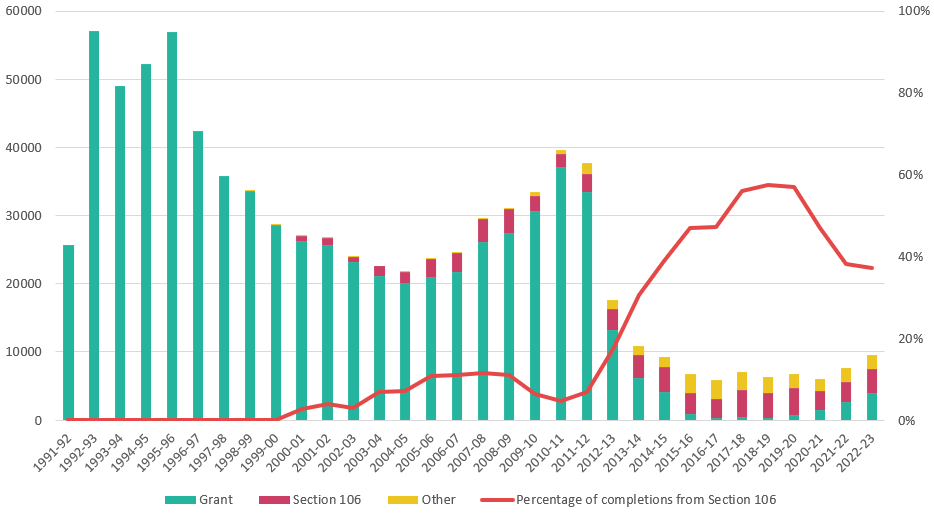[ad_1]
If the federal government needs to ship the properties the nation wants, it should commit extra funding to social housing
Yesterday, Angela Rayner introduced the federal government’s intention to reinstate housing targets for native authorities to “get Britain constructing”, aligning with Labour’s marketing campaign pledge to assemble 1.5 million properties and ship “the largest enhance in social and inexpensive housebuilding in generations.” It’s encouraging rhetoric, however with out a strong technique, dangers falling far wanting housing targets. Rachel Reeves not too long ago advised builders that we “want the personal sector to construct properties” and that the federal government shouldn’t be going to be straight funding these properties. This reluctance to supply considerably extra grant funding for housebuilding raises critical questions concerning the feasibility of such an method, particularly within the context of Angela Rayner’s pitch to create “the largest wave of council and social housing of a technology.”
This rhetorical disconnect, unresolved after the King’s Speech, factors to a heavy reliance on developer contributions by means of mechanisms like Part 106 (S106) agreements. Launched within the Nineteen Nineties, S106 are legally binding planning obligations requiring builders to contribute in the direction of inexpensive housing and infrastructure as a situation of receiving planning permission. Over the previous 15 years, S106 agreements have been essential in delivering inexpensive and social housing, accounting for roughly 47% of all inexpensive properties constructed yearly. Nevertheless, S106 outputs have fallen far wanting assembly housing wants and are unlikely to ship the federal government’s formidable targets on their very own.
Determine 1: Social lease grant versus Part 106 completions since 1991

Supply: Ministry for Housing, Communities and Native Authorities
The chancellor’s promise that the federal government is ‘not going to let [developers] off the hook,’ guaranteeing supply of each inexpensive housing and housing for social lease, provides some promise, particularly contemplating native authority planning budgets have been slashed by 43% since 2010. Lack of accountability is exploited by builders by means of the ‘viability’ loophole. Builders typically argue that offering inexpensive housing renders their initiatives financially unviable, leading to lowered inexpensive housing contributions. Analysis by Shelter discovered that the place viability assessments had been used, simply 7% of properties on new websites had been inexpensive, far beneath the common native authority goal of 28%
Enforcement isn’t the one problem. S106 agreements are likely to ship extra inexpensive housing in areas with excessive property values, exacerbating regional inequalities. For instance, London alone acquired practically 40% of all S106 contributions between 2013 and 2018, amounting to over £1.5 billion. Inequality is each regional and site-specific: there have been quite a few situations of segregation inside developments constructed below S106 agreements, to the extent that housing associations are reluctant to purchase S106 properties resulting from their low high quality. ‘Poor doorways’ controversies, the place inexpensive housing residents are given separate entrances and excluded from communal areas, spotlight the potential for these agreements to strengthen social divisions moderately than create actually blended communities.
Developer contributions alone are unlikely to fulfill the size of social housing want. Within the post-war a long time, when native authorities had been actively constructing properties, complete housing completions typically exceeded 300,000 per 12 months. This era of excessive output coincided with substantial public funding in housing and fell when governments began to rely extra on personal improvement. The post-war New Cities programme, which created locations like Basildon, Harlow, and Stevenage, was pushed by public improvement companies funded by Treasury loans. These companies had in depth powers, together with the power to buy land at existing-use worth moderately than inflated ‘hope worth.’ This method didn’t simply ship housing; it adequately addressed place-based housing wants and captured land worth uplift for the general public good. Based on the City and Nation Planning Affiliation, the £4.75 billion mortgage made to new city improvement companies was totally repaid by 1999. Current research additional strengthen the financial case for public funding in social housing; Shelter’s analysis discovered that constructing 90,000 social properties in a single 12 months would pay for itself inside three years and return £51.2 billion to the financial system.
“To really ship on its formidable housing targets, the federal government must decide to substantial public funding in social housing.”
To really ship on its formidable housing targets, the federal government must decide to substantial public funding in social housing. NEF analysis exhibits that the mixed socioeconomic worth of constructing 90,000 social properties in a single 12 months is estimated to ship web financial advantages of £11.9bn over 30 years, breaking even after 11 years to thereafter ship constructive returns. Whereas partnerships with personal builders can play a task, the state should take the lead in funding and constructing properties to fulfill the size of want.
This method ought to embody offering vital public grants to councils and housing associations for the direct constructing of social lease properties. Moreover, implementing land reforms to permit public our bodies to amass land at existing-use worth will seize the planning uplift for public profit. Strengthening planning powers is essential, giving native authorities extra strong instruments to barter and implement inexpensive housing contributions from personal builders. Reforming Inexpensive Housing Programme (AHP) price minimisation guidelines to prioritise social lease, with at the least 80% of AHP grant cash allotted to social lease and the rest break up between shared possession and inexpensive lease, is important. Moreover, permitting social landlords to mix AHP grants with different grants and sources of capital, resembling proper to purchase receipts, will improve their capability to ship the wanted properties.
By combining public funding with reformed planning obligations and prioritising social lease, the federal government can create a strong, sustainable method to delivering the social housing the nation desperately wants. This technique would allow us to construct communities, deal with the homelessness disaster, and create a extra steady and affluent society for all.
Picture: iStock
[ad_2]